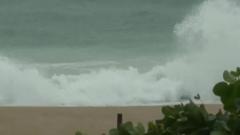Is Your Area Affected? Over 500,000 Evacuate as Typhoon Approaches Vietnam

Published: 2025-08-24 14:45:24 | Category: world
Vietnam is currently facing a significant weather emergency as Typhoon Kajiki approaches, prompting the evacuation of over 586,000 people from several central provinces. With winds exceeding 166 km/h (103 mph) and heavy rainfall expected, the storm poses serious risks to life and property. Authorities are taking extensive measures, including flight cancellations and military deployment, to ensure public safety ahead of the typhoon's landfall.
Last updated: 29 October 2023 (BST)
Overview of Typhoon Kajiki
Typhoon Kajiki is a powerful storm that has developed rapidly in the South China Sea. As it approaches Vietnam, meteorologists are closely monitoring its trajectory and potential impact. The typhoon's maximum sustained winds are projected to escalate, with forecasters warning that it could reach even higher speeds before hitting land. The storm's predicted rainfall and storm surges present a severe threat to the affected regions.
Key Takeaways
- Over 586,000 individuals are being evacuated in central Vietnam.
- Typhoon Kajiki has wind speeds of 166 km/h (103 mph) and continues to strengthen.
- Authorities have cancelled numerous flights and advised against outdoor activities post-14:00 GMT.
- Storm surges of 2-4m (6.6-13ft) are anticipated, raising concerns about flooding.
- The storm could potentially cause damage similar to Typhoon Yagi, which was devastating last year.
Current Situation in Vietnam
The Vietnamese government has issued evacuation orders for several provinces, including Thanh Hoa, Quang Tri, Hue, and Da Nang. This preemptive measure aims to safeguard lives in the face of a rapidly intensifying storm. Local officials have stressed the urgency of these evacuations, advising residents to leave their homes immediately.
Impacts of Typhoon Kajiki
The typhoon is expected to make landfall by early Monday, bringing with it catastrophic winds and heavy rainfall. According to BBC Weather, as Kajiki moves inland, it may weaken slightly but will still unleash winds of up to 200 km/h (124 mph) coupled with anticipated rainfall of 300-400mm (11.8-15.7 inches). Such conditions can lead to severe flooding, landslides, and infrastructure damage.
Comparative Risks: Kajiki vs. Previous Typhoons
Officials are particularly concerned about the potential devastation of Typhoon Kajiki, drawing parallels to Typhoon Yagi, which struck in September last year and caused significant loss of life and property in Vietnam. Reports indicated that Typhoon Yagi resulted in approximately 300 fatalities in Vietnam alone, highlighting the stakes involved in the current situation.
Evacuation and Safety Measures
In light of the impending threat, authorities are taking drastic measures to ensure public safety. Vietnam Airlines has cancelled at least 22 flights to and from central cities, effectively grounding air travel in the region. Additionally, boats have been ordered to remain ashore, and military personnel have been deployed to assist in the evacuation process and provide support in affected areas.
Emergency Services and Preparedness
The Vietnamese government is mobilising emergency services to prepare for the storm's impact. Soldiers are being deployed to assist in evacuations and provide aid to those in need. Local communities are being urged to comply with safety measures, including avoiding outdoor activities after 14:00 GMT on Sunday. Officials have described the situation as "extremely dangerous," emphasising that no vehicles or structures should be on the move during the storm.
Weather Forecast and Predictions
As Typhoon Kajiki approaches, forecasts indicate that it will bring heavy rainfall and high winds, leading to significant weather-related challenges. The storm is currently skirting past Hainan in China, with the local weather agency predicting up to 320mm (12.6 inches) of rain in some areas. This additional rainfall could exacerbate flooding in neighbouring regions, including Vietnam.
Potential Outcomes and What to Expect
While meteorologists anticipate that Typhoon Kajiki may weaken as it moves inland, the potential for widespread damage remains high. Storm surges of 2-4m (6.6-13ft) are expected, which can lead to coastal flooding and erosion. Residents in the storm's path are advised to prepare for possible power outages, disrupted transportation, and emergency services being stretched thin.
Post-Storm Recovery Efforts
In the aftermath of Typhoon Kajiki, recovery efforts will be crucial for affected communities. Historical data from previous storms, such as Typhoon Yagi, suggests that rebuilding infrastructure, providing medical assistance, and delivering food and supplies will be high priorities. The government and various organisations will need to coordinate effectively to ensure a swift recovery.
Community Awareness and Preparedness
Community awareness is vital in preparing for typhoons. Residents are encouraged to stay informed through local news channels and weather updates. Building a disaster preparedness plan and stockpiling essential supplies can make a significant difference in coping with the aftermath of severe weather events like Typhoon Kajiki.
Conclusion: A Call for Vigilance
As Typhoon Kajiki approaches, the situation remains fluid, and authorities continue to assess the storm's trajectory and potential impacts. The importance of following evacuation orders and safety guidelines cannot be overstated. The community's resilience and preparedness will play a critical role in navigating this challenging time. Residents are urged to stay vigilant and prioritise safety above all else as the storm approaches.
FAQs
What is Typhoon Kajiki's current wind speed?
Typhoon Kajiki is currently packing winds of 166 km/h (103 mph) and is expected to strengthen further before landfall.
Which areas in Vietnam are being evacuated?
Evacuations are taking place in central provinces, including Thanh Hoa, Quang Tri, Hue, and Da Nang.
What kind of rainfall is expected from Typhoon Kajiki?
Rainfall of 300-400mm (11.8-15.7 inches) is anticipated, posing a significant flood risk in the affected areas.
What safety measures are being implemented in Vietnam?
Authorities have cancelled flights, grounded boats, and deployed military personnel to assist with evacuations and ensure public safety.
How does Typhoon Kajiki compare to previous storms?
Officials are concerned that Typhoon Kajiki could cause damage similar to that of Typhoon Yagi, which resulted in hundreds of fatalities in 2022.



